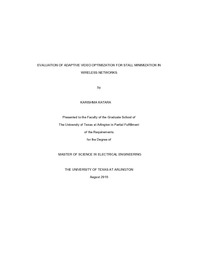
ATTENTION: The works hosted here are being migrated to a new repository that will consolidate resources, improve discoverability, and better show UTA's research impact on the global community. We will update authors as the migration progresses. Please see MavMatrix for more information.
Show simple item record
| dc.contributor.author | Katara, Karishma | en_US |
| dc.date.accessioned | 2015-12-11T23:20:07Z | |
| dc.date.available | 2015-12-11T23:20:07Z | |
| dc.date.submitted | January 2015 | en_US |
| dc.identifier.other | DISS-13290 | en_US |
| dc.identifier.uri | http://hdl.handle.net/10106/25364 | |
| dc.description.abstract | Mobile devices such as smart phones and tablets have become an integral part of peoples’ daily lives. Users are consuming more content over wireless networks than ever before, and the largest portion of that traffic by volume is delivered as video. Even with the rollout of high speed LTE networks, subscriber demand for content is growing at an overall faster rate than network capacity is being added in many urban areas. This presents a challenge to the network operators since users expect a stall-free playback experience, on devices that support high resolution and high quality content. To help maintain the subscriber experience, operators may deploy a solution to adjust the video transmission rate requirements depending on varying network capacity. Mobile users would otherwise experience sudden stalls during the video playback in a congested network. The main objective of this thesis is to analyze a system or solution to optimize video content such that finite network resources are more fairly shared, and the subscriber experience is protected during times of network congestion by reducing the number of stalls. The goal is provide smooth video playback on the mobile device with the best video quality possible by applying adaptive video optimization. Adaptive optimization allows a change in resolution, bit rate or quantization of the video in accordance with the available bandwidth. The user’s experience for the video played on these device depends mainly on the stalls and the perception of quality.Compared to the conventional compression schemes where optimization is applied universally regardless of network congestion, the adaptive optimization algorithm described in this paper adjusts the compression level applied based on the fluctuating channel throughputIn this paper, real world data collected from a live network is studied and analyzed how the number of stalls vary for dynamic compression. By simulating this scenario I can say that the highest overall playback quality possible is achieved by selecting the best video bit rate depending on the channel condition and the amount of video stream buffered in the client. | en_US |
| dc.description.sponsorship | Liang, Qilian | en_US |
| dc.language.iso | en | en_US |
| dc.publisher | Electrical Engineering | en_US |
| dc.title | Evaluation Of Adaptive Video Optimization For Stall Minimization In Wireless Networks | en_US |
| dc.type | M.Engr. | en_US |
| dc.contributor.committeeChair | Liang, Qilian | en_US |
| dc.degree.department | Electrical Engineering | en_US |
| dc.degree.discipline | Electrical Engineering | en_US |
| dc.degree.grantor | University of Texas at Arlington | en_US |
| dc.degree.level | masters | en_US |
| dc.degree.name | M.Engr. | en_US |
Files in this item
- Name:
- Katara_uta_2502M_13290.pdf
- Size:
- 2.594Mb
- Format:
- PDF
This item appears in the following Collection(s)
Show simple item record


